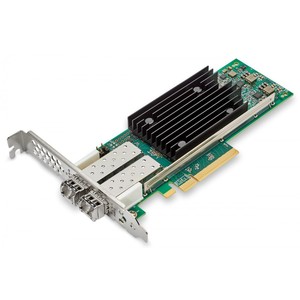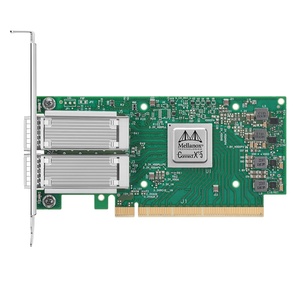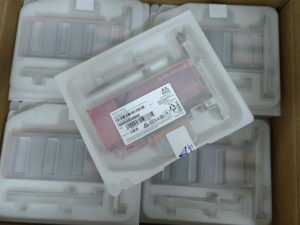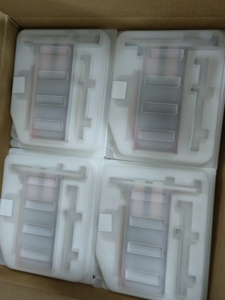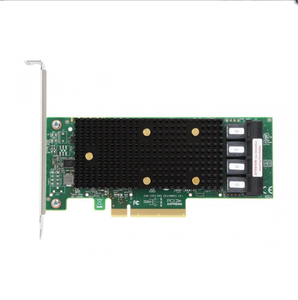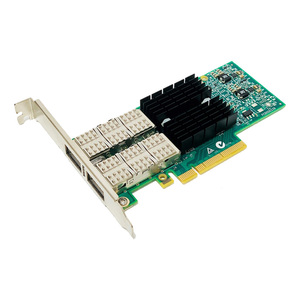Types of 10g Ethernet NICs
Many kinds of 10g Ethernet network interface cards (NICs) are suitable for various uses. Each card has distinctive features tailored for specific operational necessities and preference.
- SFP+ Network Interface Card: A Small Formfactor Pluggable Plus (SFP+) NIC is an extensively employed model of the 10g Ethernet NIC. It features a port to fit a pluggable transceiver and enables connectivity through fiber or copper cables. In addition, the SFP+ offers the flexibility to modify the transceiver type, thus adapting to distinct network requirements.
- Dual Port 10G Ethernet NICs: These NICs come equipped with two independent 10G ports on a single card. They are convenient for setting up redundant connections or segregating network traffic into diverse segments.
- Single Port 10G Ethernet NICs: As their name suggests, these NICs have one 10G port. For straightforward setups or scenarios where only one high-speed connection is necessary, they are common.
- High Profile 10G Ethernet NICs: High-profile NICs possess larger physical brackets that can fit more significant or advanced server models. More network connections or additional features may be included, such as multiple bandwidth expansion slots.
- Low Profile 10G Ethernet NICs: These NICs are designed to fit into servers or computers with compact expansion slots. They usually have smaller brackets and are ideal for devices with confined space.
- Wireless Network Interface Card (NIC): The 10g Ethernet NIC can support wireless connections, allowing network access without cables or physical links.
- PCIe Network Interface Card: Most 10g Ethernet NICs utilize the PCIe (Peripheral Component Interconnect Express) interface for connecting to servers, computers, or compatible devices. PCIe offers a fast connection pathway between the NIC and the central processing unit (CPU), thus enabling optimum performance.
Functions and features of 10g ethernet NICs
The functions of a 10 gb ethernet NIC include enabling a communication link between the computer system and the ethernet network and facilitating high-speed network connections. A 10g Ethernet card allows a user to transmit and receive data at up to 10 Gb per second. Users like gamers, content creators, and media can transfer large data files in a short time.
- Data transmission: A network interface card transmits data between a computer and an ethernet network. It does so by encapsulating ethernet frames with the respective protocol and sending them over the network.
- Data packetization: The 10 GB Network Interface Card packages data into packets. It ensures that the data can be efficiently transferred over the ethernet network. The card helps break large data into smaller packets, which makes the process smoother and reduces the chances of errors.
- Ethernet frame generation: To communicate over an ethernet network, frames need to be generated. A 10g Ethernet NIC generates these frames based on the data packets to allow for successful communication with other devices on the network.
- Features:
- Higher bandwidth enables increased speed, better CPU performance, reduced latency, and efficiency. It allows a user to use more data and increases throughput.
- Lower latency means higher responsiveness for real-time applications.
- Improved off-load functions handle tasks independently, so the CPU has more processing power for other jobs. They include iGPU, LRO, FCoE, etc.
- a 10G Ethernet adapter is compatible with existing ethernet networks. Users can connect the NICs to 1G and 10G switches and routers, ensuring flexibility.
- It is a cost-efficient way to upgrade the network speeds without overhauling the existing network infrastructure.
- Easy installation and use so that users can quickly and easily upgrade their network speed and performance.
- Support for virtualization technology, which allows multiple virtual machines to access network resources simultaneously without any disruption.
- Lower power consumption enables reduced operational costs and a more eco-friendly network environment.
Scenarios
The 10-gigabit Ethernet network interface card (NIC) shows numerous usages across various industries. The following are some highlighted applications:
- Gaming and streaming: The 10g ethernet can play games at high speeds and can stream without buffering or lagging. It gives data transfer speeds, so there are no delays or interruptions.
- Servers: In server setups, 10Gb network cards allow the NIC to connect with high-speed network switches. They can communicate quickly and send more data. These cards help servers that need to transfer large amounts of data fast.
- Video production and editing: For tasks like producing, editing, or working on videos in groups, these Ethernet cards are helpful. They make video file transfers quicker. So, many people can work on videos together without any problems.
- Data transfer: When people work on computers together in the same place, they need to share files between different PCs. Having a 10Gb Ethernet card can make transferring files between computers faster if many people are working together on these projects. It is more accessible for transferring large files, which is especially helpful when working on video.
- Surveillance: The 10Gb cards can help video camera systems. They allow video data from many cameras to be sent and stored quickly and safely. This is vital for places where security is significant.
- Medical field: These cards help hospitals and doctors get medical images faster and better. This allows medical workers to see images rapidly from various computers. It aids in diagnosing and treating patients more quickly.
- Research institutions: Scientific and technical research needs to process a lot of data quickly. These 10Gb Ethernet cards help researchers get results faster. Tasks like analyzing data or modeling computers work better with these network interface cards.
How to Choose 10g ethernet nic
When choosing a 10 Gigabit NIC, it is essential to consider the port type, operating system support, CPU load, driver support, and specific use case needs.
The first step in this process is to examine the server or computer's bus architecture, as it is where the NIC will be installed. A NIC with a PCIe interface is considered the fastest because it provides a direct connection to the CPU and memory. Other types include PCI and PCI-X, which are older designs and slower compared to the PCIe interface.
-
Port Type
Several options are available when looking for port types, such as SFP+, SFP, CXP, CX4, and copper ports. SFP+ is commonly used due to its small and hot-pluggable feature. One notable advantage is its ability to use different transceivers, making it versatile. SFP+ port can accept a variety of transceiver options that can support 10G Ethernet NIC, depending on the connectivity type, distance, and environment. These include 10GBase-T copper transceivers for standard RJ45 connections, 10GBASE-SR transceivers for short-range fiber connections, and 10GBASE-LR transceivers for long-range fiber connections. Other port types are larger and use more power.
-
Operating System Support
It is important to ensure that the chosen NIC is compatible with the operating system running on the server or computer. Take note that Windows has built-in drivers for certain hardware, which will make the setup quite easy. Linux users may have to do a bit of extra work in installing the required drivers for the newly purchased NIC.
-
CPU Load
Check how much burden the NIC will place on the CPU. Some NICs come with offload features. These features allow the NIC to handle many network tasks, reducing the NIC's impact on the CPU. This can lead to better performance, especially on machines that handle a lot of network tasks or are using older processors.
-
Driver Support
Taking a look at the support for drivers is a good idea. While many network drivers are automatically installed, some may need manual installation. Make sure that the preferred operating system is listed as one of the systems where the drivers are provided. Check for updated drivers. This shows that the manufacturer is still putting out support for the product.
10g ethernet nic FAQ
Q1. What systems are 10G Ethernet NICs compatible with?
A1. Compatibility depends on the specific NIC. Research and confirm compatibility with systems before purchasing.
Q2. How can the performance benefits of a 10G Ethernet NIC be maximized?
A2. To optimize performance, ensure that servers, switches, and other network devices support 10Gbps. Use quality cabling and learn to troubleshoot problems.
Q3. What is the difference betweenTenc Gigabit Ethernet and 10G Ethernet?
A3. Gigabit Ethernet is a network technology that can transmit data at 1000 Mbps (1Gbps). 10G Ethernet is similar but faster - it can transmit data at 10Gbps.
Q4. What are the commonest types of connectors used with 10G Ethernet?
A4. The most common are SFP/SFP+, which work with transceivers for Ethernet cables. NICs can also have built-in ports for connecting to networks.
















































































